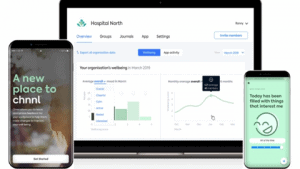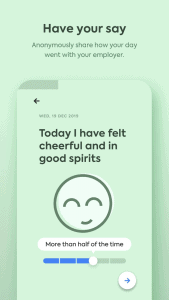Human Resources
Why Is Employee Well-Being Important at Work?
25 May 2021

Employee well-being often seems to be an aspect of work companies put-off focusing on until it’s too late. While studies have shown how employee well-being has considerable positive effects on reducing presenteeism, preventing chronic health issues, and improving day-to-day health, many companies still don’t put a focus on mental and emotional well-being at work.
So why are some still ignoring the importance of employee well-being?
In this article, we cover the current status of well-being in the workplace and the benefits of employee well-being programs. We also share some key points to remember from a recent podcast episode with Dr. Elizabeth Berryman, Founder of chnnl.
Table of Contents:
1 – What is employee well-being?
What is Employee Well-Being?
The International Labour Organization defines employee wellbeing as:
Workplace Wellbeing relates to all aspects of working life, from the quality and safety of the physical environment, to how workers feel about their work, their working environment, the climate at work and work organization.
In practice, this translates into all the policies, activities, and best practices that aim to improve an employee’s health, be it physical or mental. While the traditional outlook on well-being was to ensure employees had access to medical care, today’s workspace focuses on how well-being programs help a person feel happy and stay healthy.
Yet, organizations were slow to notice this change. Before the pandemic, Gartner reported in 2019 that as many as 87% of employees weren’t fully happy at work. Hidden behind this statistic, poor management and lack of employee well-being programs have, in many cases, taken their toll on employee engagement and mental health.
2020 brought further hurdles which are still visible this year. Remote work struggles, the uncertainty of our future and careers, and more limits on socializing and interpersonal connection are posing extra challenges to employees. At home, they have to face these alone. That’s exactly where an effective employee well-being program comes in.
4 Benefits of Employee Well-Being Programs at Work
At a first glance, making employee well-being a part of everyone’s work day seems like an easy feat. Set up a couple of one-on-ones, gather some employee feedback, have regular team outings, and you’re done. Right?
In reality, these practices don’t apply to every person. You’ll first need to understand what’s keeping your team from being happy at work and how you can motivate them to focus on their health.
Here’s why building an employee well-being program that takes every individual into account matters:
Better engagement and productivity
The increased engagement team members will show is a win-win for all. Simply being happy makes an employee 12% more likely to be productive.
Beyond it all, engagement is through the employee-employer relationship. 95% of employees who claim to be highly engaged feel the importance of their managers listening to their ideas and taking their feedback into consideration. Establishing this level of trust is the first pillar towards setting up an employee well-being program and well-being culture that’s built on every person’s needs.
Lower absenteeism and turnover
Dozens of studies show how a carefully organized employee well-being program lowers absenteeism rates for 78% of employers, saving an average of $3.27 to $6 on resulting costs for every dollar spent.
In turn, a healthy work environment motivates people and keeps them with your company for longer. Without such programs, employees are at a higher risk of burnout which causes companies to lose $125 to $190 billion every year.
A workforce built on resilience
A well-being program acts as a guiding light in terms of stress — whether employees are dealing with it at work or in their own personal lives. A healthy program focuses on teaching people how to handle unexpected events even when a counselor, family member, or friend isn’t around. This means you’ll be prioritizing your team’s well-being and resilience to help them improve their quality of life and manage crisis situations without panic.
Stronger employer branding
70% of global leaders invest in well-being programs because these positively influence their work culture. You can use these to support your employer branding goals and attract new talent that will enjoy your company’s environment. Happy employees are more likely to recommend your organization to their peers, reducing your recruitment costs and ensuring an engaged workforce.
chnnl: Employee mental health and well-being platform
On a recent episode of our podcast, The Ins and Outs of Work, we spoke with Dr. Elizabeth Berryman, Founder of chnnl.

Dr. Elizabeth Berryman founded chnnl to provide a safe environment where employees could feel safe to share their voices. Companies use chnnl’s anonymous surveys to boost productivity, retention, and create a positive work environment.
chnnl’s vision of maintaining employee well-being
The chnnl app aims to create a sense of psychological safety for all employees dealing with burnout, suicidal thoughts, workplace bullying, or other similar matters. In an environment where each person brings their own emotional baggage to work, chnnl’s vision is “to create a workplace that truly understands mental wellbeing”. This investment in humans keeps employees healthy and more productive, uplifting the organization as a whole.
An increased understanding of the importance of good mental health at work
Legislation has changed a lot over the past year in many countries around the world. With so many employees now working from home, some countries have even made company directors accountable for the psychological safety of a company’s talent.
Elizabeth shared with us some of the core changes she’s been noticing at a global scale:
Occupational safety organizations are coming in and investigating companies that don’t have psychological safety policies in their workplaces. In countries such as Japan, a company director is now liable to a prison sentence if they don’t address some health-detrimental issues.
– Dr. Elizabeth Berryman, Founder of chnnl

How well do organizations know their people?
In the past, organizations would send culture surveys once a year, not giving employees enough opportunities or the right forum to share their real thoughts. Added to that, in some industries like healthcare, individuals don’t feel they can be fully honest about their feelings, fearing they could lose their license if they were to share the truth.
Now we’re realizing that a one-off checkpoint is not cutting it. You might have a really great day when you answer that survey or a bad day which can skew those results. So there’s a lot of bias on top of people not feeling safe. With our anonymous surveys, we make sure that all of our users know that they’re 100% safe no matter what they tell us.
– Dr. Elizabeth Berryman, Founder of chnnl
On one hand, companies can use these surveys to spot early warning signs of struggles employees are experiencing at a team or department level. Every individual can also track their own mental health in a timely manner. This way, the hope is that organizations can develop cultures where individuals feel comfortable to reach out and talk to someone about what they’re experiencing.
Using the data to drive further initiatives
The core purpose of anonymous data is to get a realistic look at the general atmosphere within your organization. Getting a sense of how the relationships within your workplace evolve allows you to prevent large-scale issues and support every individual early.
Elizabeth says some employers have radically changed their understanding of employees’ behavior changes through the chnnl app data:
We bring our whole selves to work. Through a diary-form survey, managers get unique insights into what is going on with their people. What we found through the data is that most issues are connected to their personal life and then end up affecting their work performance. Once companies get to know their people in a new way they can have more compassion for them.

So how can you focus more on prioritizing employee well-being within your organization?
Read our article on humility as a critical Agile leadership trait that will help you create a resilient workforce that thrives under all conditions.


